Sunday, a commemoration of the 237th anniversary of the Battle of Brooklyn, was a great day at Green-Wood Cemetery.
The Battle of Brooklyn was a tremendously important event in American history. Fought on August 27, 1776, it was the first battle of the American Revolution after the Declaration of Independence was issued. It was the largest battle of the entire American Revolution, with approximately 50,000 soldiers, British and American, gathered on or about the field. It was the first time that American troops had fought, toe to toe, in the open field against the greatest military in the world–British armies. And, but for fate (a nor’easter that prevented the British Navy from getting its ships up into the East River and cutting off the Americans only line of retreat), it would have been the end of the American Revolution–with General George Washington and much of his army cornered in Brooklyn Heights, at the west end of Long Island, and captured.
But, for too long, the battle received short shrift from historians, who were uninterested in writing about what was an American defeat. That changed in 1920, thanks to the efforts of Charles Higgins, when Minerva, an heroic bronze saluting her sister, the Statue of Liberty, was unveiled on Battle Hill. Present that day were Assistant Secretary of the Navy and Democratic Vice Presidential candidate Franklin Delano Roosevelt as well as New York State Governor Al Smith.
It was apparent, from the 1830s, when Green-Wood was being planned, that Battle Hill was historic ground and had to be a part of the cemetery. However, little was known about what had happened on that highest point in Brooklyn during the Battle of Brooklyn. In fact, Nehemiah Cleaveland, Green-Wood’s first historian, wrote that little actual fighting had occurred there. Was he wrong! In 2009, Charles H. Lewis’s ground-breaking book, Cut Off: Colonel Jedediah Huntington’s 17th Continental (Conn.) Regiment at the Battle of Long Island, August 27, 1776, was published. In it, Lewis documents the historic importance of Battle Hill. It is indeed hallowed ground. As the Battle of Brooklyn (also referred to as the Battle of Long Island) developed, and American troops faced south to form a line between 18th and 20th Streets near what is now Fifth Avenue, they looked to the east and saw a hill in the distance. Realizing its strategic importance, 300 men were sent, at the double-quick, to seize it. But, as men from Connecticut, Pennsylvania, and Delaware approached the hill, they were fired upon by British soldiers, who had beaten them to that spot. The Americans pressed on and seized the hill, then held it, though severely outnumbered (the British attacking force consisted of 2000 men), against two counter-assaults. When the smoke cleared, the British had suffered 86 killed or wounded. Nowhere else during the Battle of Brooklyn did the British suffer so many casualties.
This year was a very special year for our Battle of Brooklyn commemoration because Charles H. Lewis’s research has now been incorporated into new interpretive signage on Battle Hill. We are very thankful to him for his research. And we are thankful to the Society of the Cincinnati in the State of Connecticut, which paid for the new signage and the new bronze plaque, in tribute to Huntington’s 17th Continental (Connecticut) Regiment, on Battle Hill.
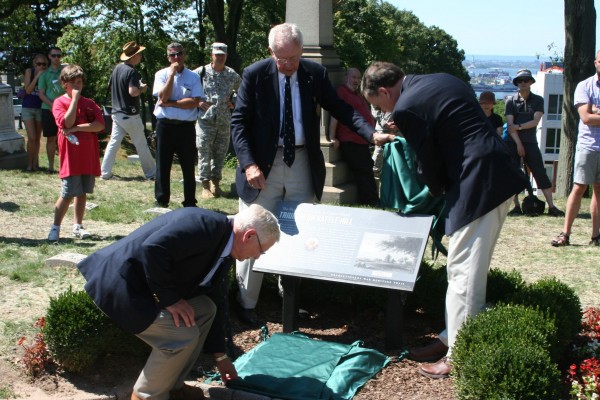
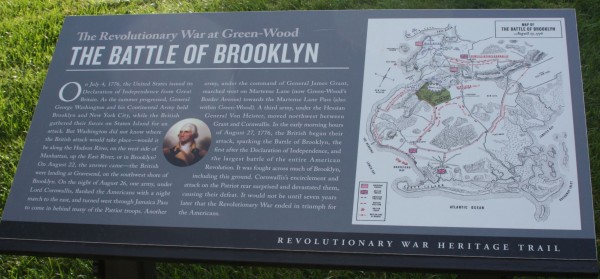
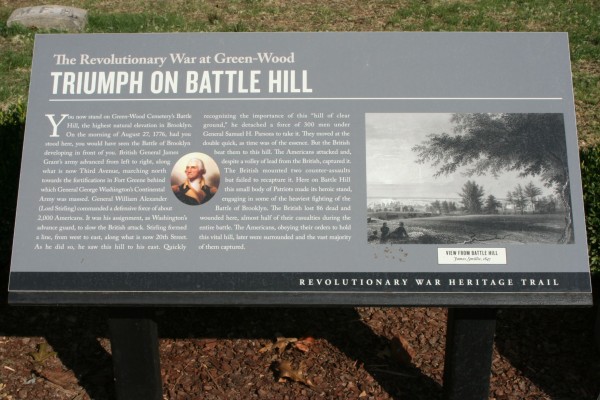
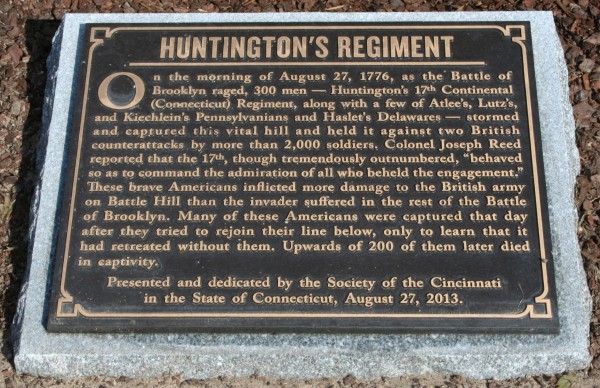
The commemoration began this year with a Battle of Brooklyn trolley tour across Green-Wood’s grounds, led by historian Barnet Schecter and Green-Wood historian Jeff Richman.
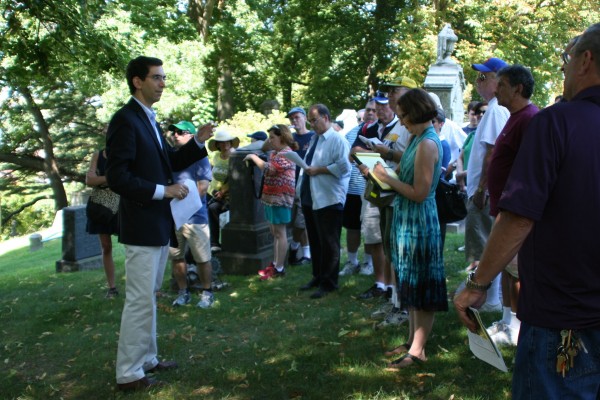
The tour was highlighted by a visit to Ocean Hill, where General George Washington, on the eve of battle, likely surveyed the British troops in the distance. The trolley then drove the attack route along Martense Lane (now Border Avenue) that was used by British General James Grant and his 5000 man army. It continued to Martense Lane Pass, where Grant’s advance was slowed by Delaware troops. After a visit to the Delaware Monument, dedicated in 2001, it was then off to Sylvan Heights, from which American sharpshooters harassed Grant’s march. The tour concluded on Battle Hill.
This year, more than 1000 visitors came to witness an 18th-century cooking demonstration, games, military drills, and a firing demonstration in Green-Wood’s Meadow. Muskets and an artillery piece were fired.
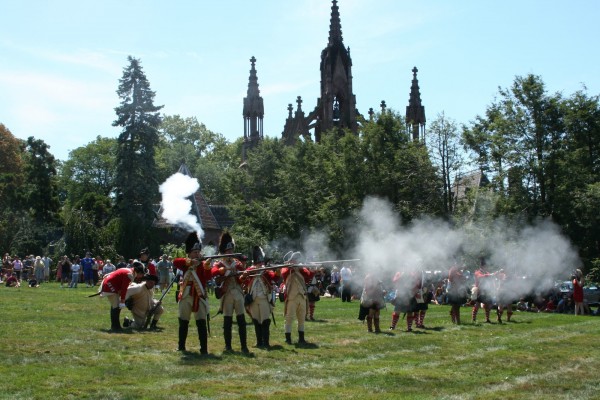
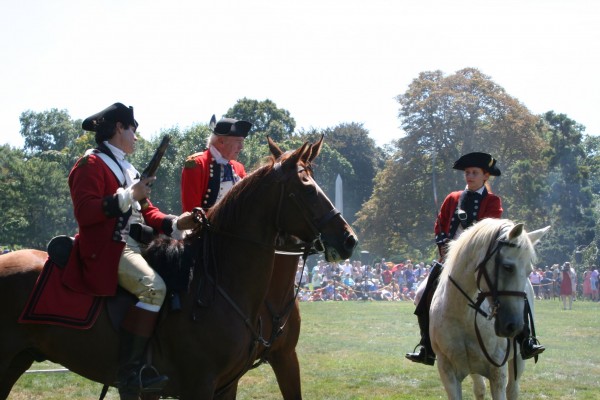
Then it was time for the Battle of Brooklyn Parade from Green-Wood’s Main Gates up to Battle Hill. The Merchant Marine Academy Band led the way, followed by re-enactors in uniform and citizens who took the 80 plus reproduction flags that American and their French allies had carried during the Revolutionary War.
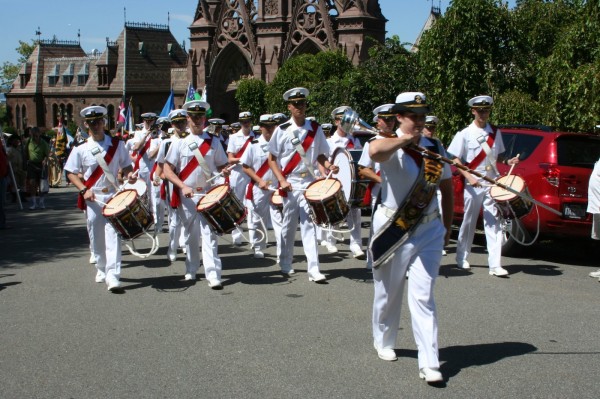
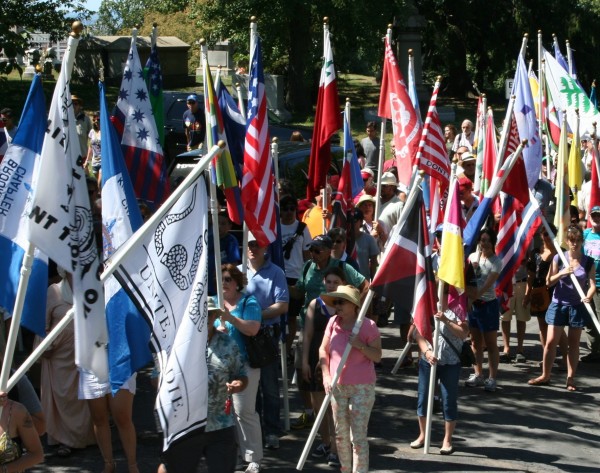
This year, we also were joined by a blue ribbon Maryland delegation, including Governor Martin O’Malley and Speaker of the State Senate Thomas V. Mike Miller, which came up to join the commemoration. The governor spoke of the sacrifice of the Maryland 400 at what is now the Old Stone House, about one mile north of Green-Wood. Marylanders Theresa Whittaker and Frank Schwartz sang “The Old Line.”
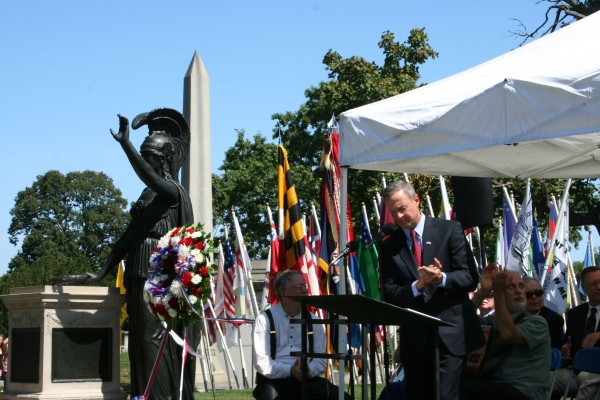

Jeff Richman did an “A-1” job on Sunday.
It was my first time to his splendid Cemetary.
My grandfather, 6 times removed, died on Battle Hill
from wounds he received at the Battle of Brooklyn.
I was proud to see that his regiment, Huntington’s 17th from CT
was honored for their sacrifice.
Having witnessed the unveiling of the plaque – I was that little bit prouder
of Captain Joseph Jewett. Rest you, grandfather. We salute you.
My 6th great grandfather was with Captain Jewett…he was Sgt. Roswell Graves. He was bayoneted in the thigh when your 6th great grandfather (Captain Jewett) was stabbed twice. Grandfather Roswell died in captivity in Dec 1776. I will be making a trek to this place to pay my respects.
God bless your patriot ancestor. May he test in peace under a free sky that he helped make.
I too had an ancestor fighting there though not part of the main action. He was posted in kings bridge guarding supply lines snd any potential retreat.
Rich p.
Mr. Lyle,
I may be your 5th or 6th cousin. Just recently I learned of my lineage to our valiant (5th) great grandfather, through Ancestry and confirmed via the DAR.
I wish I had been there to help honor him. So glad “family” was there. I hope in some way he knows his sacrifice was not in vain, and he is still so lovingly remembered.
Regards
Catharine House Rowe
I seem to remember that the battle line was between 38th and 40th Sts between
what is now 3rd and 5th Ave., and, that there was only a small skirmish in Greenwood cemetery involving the Hessians (or British) shooting and killing a soldier who had gone
there to forage for watermelons along with some fellow American soldiers -. I also
recall that the British wouldn’t allow the fallen American to be buried .
I lead a walk retracing some of the Battle route starting from VZ bridge, into Greenwood,
onto the Old Stone House and ending at Fulton Ferry. John Gallagher used to lead this
walk for some walking clubs.
Thanks for your comment.
The British had three armies. One, under Generals Cornwallis and Clinton, marched to the east and north, at night, then turned to the west and came through Jamaica Pass, coming in behind the American advance guard under Lord Stirling. The second army, Hessians under De Heister, marched to the northwest and came through Flatbush Pass, then got the the Vechte House (now the Old Stone House). The third army, under General James Grant, divided–part of it came up the Narrows Road along the western coast of Brooklyn, while the other part marched, under cover of darkness, up Martense Lane to Martense Lane Pass. Martense Lane is now Border Avenue in Green-Wood. Martense Lane Pass is also in Green-Wood–Fifth Avenue goes over it. The watermelon patch, where Delaware troops exchanged fire with General Grant’s soldiers, was also on land that is now in Green-Wood. And there were Patriot sharpshooters on Sylvan Heights–land that now is also Green-Wood–who harassed Grant’s advance. Further, there was substantial action near what would become Green-Wood, when Stirling formed a line between what is now 18th and 20th Streets. And 300 men from that line stormed up to Battle Hill (now in Green-Wood), forced the British off that hill, then held it against two counterassaults by 2000 British regulars. The heavy fighting on Battle Hill is no merefootnote to the battle; the British suffered more casualties–86 killed or wounded–up on Battle Hill than at any other place during the Battle of Brooklyn. You really should buy yourself a copy of Charles H. Lewis’s “Cut Off,” published in 2009 and laying out his groundbreaking research on what really happened on Green-Wood’s Battle Hill, and update your knowledge.
This was an outstanding event. I have always been confused about what happened to the Connecticut units at the Battle of Brooklyn as previous accounts always seemed contradictory and incomplete. After hearing Mr. Lewis’s speech at the commemoration, I went straight to the library to find his book and now it finally all makes sense. Thanks to all for a wonderful day.
It is my understanding that a new marker commemorating the Maryland 400 was unveiled at this event. Where could I find an image of this marker and its coordinates (for use in my webpage on the Marylander burial sites?
No, no such marker to the Maryland 400 was unveiled. In addition to two signs interpreting Green-Wood and the Battle of Brooklyn, a bronze plaque to Huntington’s Regiment (the 17th, primarily raised in Connecticut) was unveiled.
I am very proud to say that my great great great grandfather, Michael Mitchell, patriot, fought in the 17th regiment during this battle. He was captured and sent to a British prison ship where he starved to death.
My great-grandfather was Charles M. Higgins. I have done research on him, which I’ll admit was scetchy, but intriguing. I was led to this, and am pleasantly surprised by the debt he made in society, and his memory lives on. I am keen on visiting my families mausoleum when the opportunity reveals itself. (I also love that he built a statue.)
Yes, you should definitely visit. I would be happy to show you around the mausoleum. It is quite impressive, with the inscriptions inside. He was a great patriot–and, as an immigrant, fully understood what made America great.
My Ancestor’s name was Higgins also, from Knockcroghery, Co Roscommon. Ireland.
Patrick born in 1868. Immigrated to Brooklyn. NY.
I learned that he was a surveyor.
Wo love to get more Info of him.